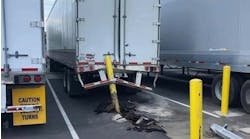Information about navigation systems has grown from a trickle to a steady flow over the last many months as the technology has gained followers-- pun intended-- around the globe. Quantifying the benefits of newer IT capabilities can be challenging for fleets, though, due to a lack of solid data and research on these still-developing technology tools.
Help is at hand. Back in June of 2005, the U.S. Department of Transportation, Federal Highway Administration issued a 10-pg. report on the Intelligent Transportation Systems website (www.itsdocs.fhwa.dot.gov/jpodocs/repts_te/14073_files/sec_3_2.htm) called, “ITS Benefits, Costs and Lessons Learned: 2005 Update.” While it was not widely publicized, the report makes good reading for any fleet interested in assessing the benefits of various technology-based driver assistance systems, including onboard navigation, driver communication and adaptive cruise control – 12 technologies in all.
In the case of navigation systems, the report notes that, “In vehicle navigation and route guidance systems with Global Positioning System (GPS) technology may reduce driver error, increase safety, and save time by improving driver decisions in unfamiliar areas.”
Some of the specific findings: Field data and simulation models in one project showed that navigation/route guidance users could decrease their crash risk by up to 4%. A test in Italy demonstrated timesavings of more than 10% for cars equipped with in-vehicle navigation devices. Yet another project showed that the use of navigation systems could help to improve the traffic-handling capacity of highways.
In the meantime, the adoption of navigation systems continues to briskly expand. In this week alone, for example, Navteq (www.navteq.com), one of the leading suppliers of digital map data for vehicle navigation made several announcements about new technology partners.
Yesterday, the company announced that it has been chosen by Manning NavCom, Inc. to provide Navteq map data of Mexico for Manning NavCom’s Rastrac vehicle tracking solution. Navteq’s navigable database of Mexico covers 234,398 miles and provides street network data for more than 3,000 urban and suburban towns, which includes more than 70% of the population.
Earlier in the week, Navteq also published news of another new contract, this one with Canada’s Datacom Wireless Corporation (www.datacom.com). According to Navteq, their map data will be utilized in Datacom’s Mobilus, a tracking system designed specifically to track stolen vehicles, and in Mobicom, an Internet-delivered fleet management solution that incorporates GPS tracking technology.
In other news, Navteq also announced that it was purchasing The Map Network, a privately held Washington, D.C.-based producer of official maps for travel destinations, special events and major hotel marquee venues (www.mapnetwork.com).
The acquisition, for $37.5 million in cash, will permit Navteq to add more local content, which has been The Map Network’s forte. The Map Network produces detailed print and on-line maps for over 90 U.S. cities; more than 200 trade shows and events; and a number of convention centers, stadiums and even hotels. The problem of getting lost anywhere, it seems, may itself be getting lost in the details.


